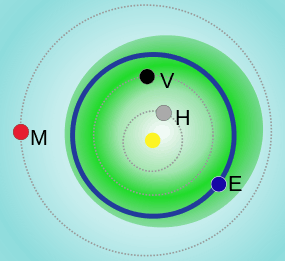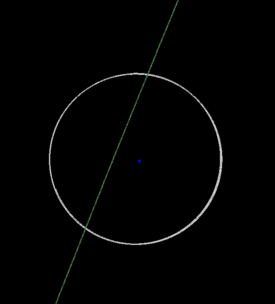(153814) 2001 WN5
|
Nominal orbit of 2001 WN5 passing the Earth–Moon system in June 2028. Earth is the blue dot, the Moon's orbit is gray, and 2001 WN5 is green. | |
| Discovery[1] | |
|---|---|
| Discovered by | LONEOS Project (699) |
| Discovery date | 20 November 2001 |
| Designations | |
| MPC designation | (153814) 2001 WN5 |
Apollo  NEO, PHA[1] | |
| Orbital characteristics[1] | |
| Epoch 13 January 2016 (JD 2457400.5) | |
| Uncertainty parameter 0 | |
| Observation arc | 7327 days (20.06 yr) |
| Aphelion | 2.5119 AU (375.77 Gm) (Q) |
| Perihelion | 0.91167 AU (136.384 Gm) (q) |
| 1.7118 AU (256.08 Gm) (a) | |
| Eccentricity | 0.46742 (e) |
| 2.24 yr (818.05 d) | |
| 142.30° (M) | |
| 0° 26m 24.252s / day (n) | |
| Inclination | 1.9212° (i) |
| 277.61° (Ω) | |
| 44.439° (ω) | |
| Earth MOID | 0.00199619 AU (298,626 km) |
| Jupiter MOID | 2.82453 AU (422.544 Gm) |
| Physical characteristics | |
| Dimensions | 700–1,500 m[2] |
| 18.3[1] | |
|
| |
(153814) 2001 WN5 is a near-Earth asteroid of the Apollo group.[1] It was first discovered by the LONEOS Project at Anderson Mesa on November 20, 2001,[1] and was later classified as a Potentially Hazardous Asteroid (PHA). It was removed from the Sentry Risk Table on January 30, 2002.[3] There are precovery images dating back to February 10, 1996.[1] The orbit is well determined with an observation arc of 14.9 years using two radar delay observations, and has an Uncertainty Parameter of 0.[1] The asteroid will pass within 250,000 km (0.65 lunar distances) from the Earth on June 26, 2028.[4] During the close approach, the asteroid should peak at about apparent magnitude 6.7,[5] and will be visible in binoculars. It has an absolute magnitude (H) of 18.2.[1] Depending on its characteristics and albedo, it is estimated to be 700 to 1,500 meters in diameter.[2]
References
- 1 2 3 4 5 6 7 8 9 "JPL Small-Body Database Browser: 153814 (2001 WN5)" (2011-01-04 last obs and observation arc=14.9 years). Jet Propulsion Laboratory. Retrieved 7 April 2016.
- 1 2 "Absolute Magnitude (H)". NASA/JPL. Archived from the original on 1 September 2008. Retrieved 2008-08-30.
- ↑ "Date/Time Removed". NASA/JPL Near-Earth Object Program Office. Retrieved 2011-10-16.
- ↑ "JPL Close-Approach Data: 153814 (2001 WN5)" (2011-01-04 last obs and observation arc=14.9 years). Retrieved 2011-10-16.
- ↑ "2001WN5 Ephemerides for 26 Jun 2028". NEODyS (Near Earth Objects - Dynamic Site). Retrieved 2011-10-16.
External links
- Orbital simulation from JPL (Java) / Horizons Ephemeris
- Sormano Astronomical Observatory: Close encounter between Asteroid (153814) 2001 WN5 and Earth, diagrams and orbit evolution
- (153814) 2001 WN5 at the JPL Small-Body Database
| Preceded by 367943 Duende (2012 DA14) |
Large NEO Earth close approach (inside the orbit of the Moon) 26 June 2028 |
Succeeded by 99942 Apophis |
